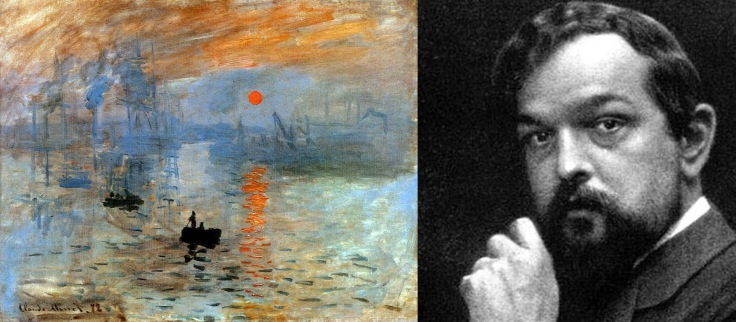
Debussy’s Style
Claude Debussy (1862-1918) was a French composer of the late Romantic period and early Modern period.
His most significant contribution to music history was that he was the progenitor of the Impressionist style, which was a form of music that featured unorthodox textures, dreamlike harmonies, and ethereal melodies.
Music that emphasized these types of sounds became common during the 20th-century, and Debussy can be considered a 20th-century composer.
Period names like 20th-century, Modern, and Impressionist can be confusing, so it is best to have some music-history-timeline software running on your brain.
Here are how the later periods of Western art music break down according to Wikipedia:
- Classical (1730-1820)
- Romantic (1780-1910)
- Impressionist (1875-1925)
- Modern (1890-1975)
- 20th-century (1900-2000)
- Contemporary (1975-present)
- 21st-century (2000-present) (“Art music” sidebar 1)
The name for Debussy’s period, Impressionist, comes from an 1872 oil painting by Claude Monet (1840-1926) called Impression, Sunrise (Schonberg 453).
The painting style of Monet was marked by subject matter expressed with vague suggestion rather than precise representation. Debussy’s music was this way, too. Instead of using the precision and clarity of the major and minor scales, Debussy often favored the ambiguity and vagary of the pentatonic and whole-tone scales (Randell 180).
With pitch collections like the pentatonic scale and the whole-tone scale, it is possible to construct melodies that wander without a destination in a manner suggestive of a dream.
Wandering dreamily without destination is the primary character trait of Impressionist music.
The Character of Debussy
Debussy was surly, easily offended, and egotistical. Consequently, he didn’t have many friends. He much preferred cats to people, and he disliked performing and conducting despite being a master at both.
Debussy’s unusual temperament, style, and talent earned him many detractors. Regardless of this, his music garnered many devotees, and he is usually considered the greatest French composer.
Here is Debussy on his thinking about music:
I am more and more convinced that music, by its very nature, is something that cannot be cast into a traditional and fixed form. It is made up of colors and rhythms. The rest is a lot of humbug invented by frigid imbeciles riding on the backs of the Masters… (Schonberg 456).
Debussy’s rejection of “frigid imbeciles” is best characterized by his piano music.
Debussy’s Piano Music
Students of music history can differentiate Debussy from the rest of the Romantic composers by noting his apathy towards Beethoven.
Remember, nearly all the Romantics considered Beethoven to be the undisputed king of the universe. Debussy, however, had this to say about him, “I became finally and completely convinced that Beethoven definitely wrote badly for the piano” (Schonberg 462).
Debussy much preferred the light touch and subtle tone of Chopin over the blunt touch and thundering tone of Beethoven. Debussy went even further than Chopin in this direction. He felt that a pianist should, “penetrate into the notes,” and that the piano should sound like an “instrument without hammers” (Schonberg 462).
Debussy achieved this by using the damper pedal with significant effect and by eschewing nearly all the rules of harmony. The result is piano music designed to be diaphanous, vague, and sensual.
Almost all Debussy’s music featured a descriptive title that hammered away at this sensual component. Claire de la Lune, which means “light of the moon,” is one such example, but there are many others (“Claire de la Lune” para 4).
Claire de la Lune is part of a collection of piano pieces composed in 1890 (but not finalized until 1905) known as the Suite bergamasque. The word bergamasque refers to an Italian folk dance, and the word suite means a collection of musical pieces meant to be played in succession. There are four pieces in this collection: Prelude, Menuet, Clair de lune, and Passepied (“Suite bergamasque” para 2).
These pieces sound like the auditory hallucinations of a person drifting off to sleep.
Suite bergamasque. “Claire de la Lune.” (1890-1905) :
Debussy’s Orchestral Music
Debussy managed to map his dreamy piano thoughts onto the orchestra, and the results of his efforts sound like nothing previously heard on Earth. One example of this is the orchestral suite called, Trois Nocturnes, which is translated as “Three Nocturnes.”
This piece has three movements featuring descriptive titles that are meant to capture the central impression of each. The first movement is called Nuages, which means “clouds,” the second movement is called Fetes, which means “festivals,” and the third movement is called Sirenes, which means “sirens.”
The first movement, Nuages, represents the perfect distillation of the Impressionist style. Listen to this music and imagine the world just a little bit out of focus.
Perhaps you’ll get the impression of some clouds drifting by.
Trois Nocturnes. “Nuages.” (1899):
Conclusion
You can summarize Debussy as follows: he was a French composer who wrote unusual music using unusual techniques. The style he championed became known as the impressionist style.
Debussy died (of cancer) in 1918 during a World War I, German bombardment.
Works Cited
“Art music.” The Free Encyclopedia. Wikimedia Foundation, Inc. 8 April 2016.
“Claire de la Lune.” The Free Encyclopedia. Wikimedia Foundation, Inc. 8 April 2016.
Norton/Grove. The Norton/Grove Concise Encyclopedia of Music. Ed. Sadie, Stanley. New York: W.W. Norton and Company, 1994.
Schonberg, Harold, C. The Lives of the Great Composers. 3rd Ed. New York: W.W. Norton and Company, 1997.
“Suite bergamasque.” The Free Encyclopedia. Wikimedia Foundation, Inc. 9 April 2016.

Nice! I love Debussy!
Thanks, man. Yeah, he was great at setting a dreamy mood.